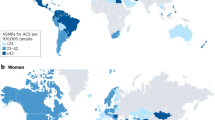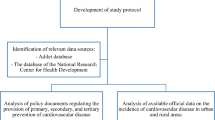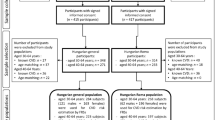Abstract
This Review presents data describing the health burden of cardiovascular disease (CVD) within and across the WHO European Region. CVD remains the most common cause of death in the region. Deaths from CVD in those aged <70 years, commonly referred to as premature, are a particular concern, with >60 million potential years of life lost to CVD in Europe annually. Although more women than men die from CVD, age-standardized rates of both morbidity and death are higher in men, and these differences in rates are greatest in individuals aged <70 years. Large inequalities in all measures of morbidity, treatment and mortality can be found between countries across the continent and must be a focus for improving health. Large differences also exist in the data available between countries. The development and implementation of evidence-based preventive and treatment approaches must be supported in all countries by consistent surveillance and monitoring, such that we can quantify the health burden of CVD as well as target interventions and provide impetus for action across Europe.
Key points
-
Cardiovascular disease (CVD) remains the most common cause of death in the European region.
-
More than 60 million potential years of life are lost to CVD in Europe annually.
-
More women than men die from CVD in Europe.
-
Age-standardized rates of both morbidity and death from CVD are higher in men than in women.
-
Deaths from cancer exceeded those from CVD in 15 of the 53 European region countries for men and in six countries for women.
-
Large disparities in data coverage and in country-level morbidity, treatment outcomes and mortality from CVD exist across Europe.
This is a preview of subscription content, access via your institution
Access options
Access Nature and 54 other Nature Portfolio journals
Get Nature+, our best-value online-access subscription
$29.99 / 30 days
cancel any time
Subscribe to this journal
Receive 12 print issues and online access
$209.00 per year
only $17.42 per issue
Buy this article
- Purchase on Springer Link
- Instant access to full article PDF
Prices may be subject to local taxes which are calculated during checkout






Similar content being viewed by others
References
Roth, G. A. et al. Global, regional, and national age-sex-specific mortality for 282 causes of death in 195 countries and territories, 1980–2017: a systematic analysis for the Global Burden of Disease Study 2017. Lancet 392, 1736–1788 (2018).
Nichols, M., Townsend, N., Scarborough, P. & Rayner, M. European cardiovascular disease statistics 4th edition 2012: EuroHeart II. Eur. Heart J. 34, 3007–3013 (2013).
Nichols, M., Townsend, N., Scarborough, P. & Rayner, M. Cardiovascular disease in Europe 2014: epidemiological update. Eur. Heart J. 35, 2950–2959 (2014).
Wilkins, E. et al. European cardiovascular disease statistics 2017. European Heart Network https://ehnheart.org/cvd-statistics/cvd-statistics-2017.html (2017).
Timmis, A. et al. European Society of Cardiology: cardiovascular disease statistics 2017. Eur. Heart J. 39, 508–579 (2018).
Timmis, A. et al. European Society of Cardiology: cardiovascular disease statistics 2019. Eur. Heart J. 41, 12–85 (2020).
Townsend, N. et al. Cardiovascular disease in Europe: epidemiological update 2016. Eur. Heart J. 37, 3232–3245 (2016).
Townsend, N., Nichols, M., Scarborough, P. & Rayner, M. Cardiovascular disease in Europe — epidemiological update 2015. Eur. Heart J. 36, 2696–2705 (2015).
Tadayon, S., Wickramasinghe, K. & Townsend, N. Examining trends in cardiovascular disease mortality across Europe: how does the introduction of a new European Standard Population affect the description of the relative burden of cardiovascular disease? Popul. Health Metr. 17, 6 (2019).
Nichols, M., Townsend, N., Scarborough, P. & Rayner, M. Trends in age-specific coronary heart disease mortality in the European Union over three decades: 1980–2009. Eur. Heart J. 34, 3017–3027 (2013).
Shah, R. et al. Epidemiology report: trends in sex-specific cerebrovascular disease mortality in Europe based on WHO mortality data. Eur. Heart J. 40, 755–764 (2019).
Wilson, L., Bhatnagar, P. & Townsend, N. Comparing trends in mortality from cardiovascular disease and cancer in the United Kingdom, 1983–2013: joinpoint regression analysis. Popul. Health Metr. 15, 23 (2017).
WHO. Global status report on noncommunicable diseases 2014. World Health Organization https://apps.who.int/iris/handle/10665/148114 (2014).
WHO. Global status report on noncommunicable diseases 2010 https://www.who.int/nmh/publications/ncd_report_full_en.pdf (2011).
WHO. Global action plan for the prevention and control of noncommunicable diseases 2013–2020. World Health Organization https://www.who.int/publications/i/item/9789241506236 (2013).
Townsend, N. in Encyclopedia of Cardiovascular Research and Medicine Vol. 2 (eds Sawyer, D. B. & Vasan, R. S.) 248–257 (Elsevier, 2017).
Vardas, P., Maniadakis, N., Bardinet, I. & Pinto, F. The European Society of Cardiology Atlas of Cardiology: rational, objectives, and methods. Eur. Heart J. Qual. Care Clin. Outcomes 2, 6–15 (2015).
WHO. World health statistics 2019: monitoring health for the SDGs, sustainable development goals. World Health Organization https://www.who.int/publications/i/item/world-health-statistics-2019-monitoring-health-for-the-sdgs-sustainable-development-goals (2019).
United Nations Statistics Division. Standard country or area codes for statistical use (M49). United Nations https://unstats.un.org/unsd/methodology/m49/ (2018).
Nicholls, M. The ESC Atlas of Cardiology. Eur. Heart J. 1, 7–8 (2019).
Lüscher, T. F. Epidemiology of cardiovascular disease: the new ESC Atlas and beyond. Eur. Heart J. 39, 489–492 (2018).
WHO. WHO methods and data sources for country-level causes of death 2000–2015. World Health Organization https://www.who.int/healthinfo/global_burden_disease/GlobalCOD_method_2000_2015.pdf (2017).
WHO. WHO methods and data sources for country-level causes of death 2000–2012. World Health Organization https://www.who.int/healthinfo/global_burden_disease/GlobalCOD_method_2000_2012.pdf (2014).
WHO. WHO methods and data sources for country-level causes of death 2000–2016. World Health Organization https://www.who.int/healthinfo/global_burden_disease/GlobalCOD_method_2000-2016.pdf (2018).
Curtin, L. R. & Klein, R. J. Direct standardization (age-adjusted death rates). US Centers for Disease Control and Prevention/National Center for Health Statistics https://www.cdc.gov/nchs/data/statnt/statnt06rv.pdf (1995).
Pace, M. et al. Revision of the European Standard Population. Report of Eurostat’s task force. eurostat https://ec.europa.eu/eurostat/documents/3859598/5926869/KS-RA-13-028-EN.PDF/e713fa79-1add-44e8-b23d-5e8fa09b3f8f (2013).
UN General Assembly. Political declaration of the high-level meeting of the general assembly on the prevention and control of non-communicable diseases. https://www.who.int/nmh/events/un_ncd_summit2011/political_declaration_en.pdf (2011).
WHO. Noncommunicable diseases global monitoring framework: indicator definitions and specifications. World Health Organization https://www.who.int/publications/i/item/ncd-gmf-indicator-definitions-and-specifications (2014).
Jaul, E. & Barron, J. Age-related diseases and clinical and public health implications for the 85 years old and over population. Front. Public Health 5, 335 (2017).
Cao, B., Bray, F., Ilbawi, A. & Soerjomataram, I. Effect on longevity of one-third reduction in premature mortality from non-communicable diseases by 2030: a global analysis of the Sustainable Development Goal health target. Lancet Glob. Health 6, e1288–e1296 (2018).
Gardner, J. W. & Sanborn, J. S. Years of potential life lost (YPLL)—what does it measure? Epidemiology 1, 322–329 (1990).
Romeder, J. M. & McWhinnie, J. R. Potential years of life lost between ages 1 and 70: an indicator of premature mortality for health planning. Int. J. Epidemiol. 6, 143–151 (1977).
Naghavi, M. et al. Global, regional, and national age-sex specific mortality for 264 causes of death, 1980–2016: a systematic analysis for the Global Burden of Disease Study 2016. Lancet 390, 1151–1210 (2017).
Kassebaum, N. J. et al. Global, regional, and national disability-adjusted life-years (DALYs) for 315 diseases and injuries and healthy life expectancy (HALE), 1990–2015: a systematic analysis for the Global Burden of Disease Study 2015. Lancet 388, 1603–1658 (2016).
Murray, C. J. Quantifying the burden of disease: the technical basis for disability-adjusted life years. Bull. World Health Organ. 72, 429 (1994).
OECD. Health at a glance 2011: OECD indicators. OECD https://www.oecd.org/els/health-systems/49105858.pdf (2011).
OECD. Health at a glance 2015: OECD indicators. OECD https://doi.org/10.1787/health_glance-2015-en (2015).
OECD. OECD health statistics. OECD https://doi.org/10.1787/health-data-en (2015).
Cleveland, W. S. Robust locally weighted regression and smoothing scatterplots. J. Am. Stat. Assoc. 74, 829–836 (1979).
Di Chiara, A. & Vanuzzo, D. Does surveillance impact on cardiovascular prevention? Eur. Heart J. 30, 1027–1029 (2009).
Barrett-Connor, E. et al. A nationwide framework for surveillance of cardiovascular and chronic lung diseases. Institute of Medicine of the National Academies https://www.nap.edu/resource/13145/National%20Surveillence%20Systems%202011%20Report%20Brief.pdf (2011).
Roger, V. L. Cardiovascular disease surveillance in the comparative effectiveness landscape. Circ. Cardiovasc. Qual. Outcomes 2, 404–406 (2009).
Goff, D. C. Jr et al. Essential features of a surveillance system to support the prevention and management of heart disease and stroke: a scientific statement from the American Heart Association Councils on Epidemiology and Prevention, Stroke, and Cardiovascular Nursing and the Interdisciplinary Working Groups on Quality of Care and Outcomes Research and Atherosclerotic Peripheral Vascular Disease. Circulation 115, 127–155 (2007).
Bhatnagar, P., Wickramasinghe, K., Williams, J., Rayner, M. & Townsend, N. The epidemiology of cardiovascular disease in the UK 2014. Heart 101, 1182–1189 (2015).
Bhatnagar, P., Wickramasinghe, K., Wilkins, E. & Townsend, N. Trends in the epidemiology of cardiovascular disease in the UK. Heart 102, 1945–1952 (2016).
Nerbrand, C., Svārdsudd, K., Hörte, L. G. & Tibblin, G. Geographical variation of mortality from cardiovascular diseases: the project ‘Myocardial Infarction in mid-Sweden’. Eur. Heart J. 12, 4–9 (1991).
Sulo, G. et al. Cardiovascular disease and diabetes mellitus in Norway during 1994–2009 CVDNOR — a nationwide research project. Norsk Epidemiol. https://doi.org/10.5324/nje.v23i1.1609 (2013).
Shalnova, S. A. et al. Cardiovascular mortality in 12 Russian Federation regions — participants of the “Cardiovascular Disease Epidemiology in Russian Regions” study. Russ. J. Cardiol. 5, 6–11 (2012).
Olsen, G. S., Holm, A.-S. S., Jørgensen, T. & Borglykke, A. Distribution of ideal cardiovascular health by educational levels from 1978 to 2006: a time trend study from the capital region of Denmark. Eur. J. Prev. Cardiol. 21, 1145–1152 (2014).
Dornquast, C. et al. Regional differences in the prevalence of cardiovascular disease: results from the German Health Update (GEDA) from 2009–2012. Dtsch. Ärztebl. Int. 113, 704 (2016).
Dorobanţu, M. et al. Total cardiovascular risk estimation in Romania. Data from the SEPHAR study. Rom. J. Intern. Med. 46, 229 (2008).
Faeh, D., Gutzwiller, F., Bopp, M. & Group, S. N. C. S. Lower mortality from coronary heart disease and stroke at higher altitudes in Switzerland. Circulation 120, 495 (2009).
Bergman Marković, B. et al. Continental–Mediterranean and rural–urban differences in cardiovascular risk factors in Croatian population. Croat. Med. J. 52, 566–576 (2011).
Plat, A. W. et al. Regional differences in cardiovascular risk factor profile cannot fully explain differences in cardiovascular morbidity in the Netherlands: a comparison of two urban areas. Neth. J. Med. 63, 309–315 (2005).
Doryńska, A. et al. Cardiovascular disease (CVD) risk factors in Kraków and in the whole Poland adult population. Results from the WOBASZ study and Polish arm of the HAPIEE project. Przegl. Epidemiol. 69, 79–86 (2015).
Mikkelsen, L., Lopez, A. & Phillips, D. Why birth and death registration really are vital statistics for development. United Nations Development Programme: Human Development Reports http://hdr.undp.org/en/content/why-birth-and-death-registration-really-are-%E2%80%9Cvital%E2%80%9D-statistics-development (2015).
Dicker, D., Nguyen, G., Lopez, A. D. & Murray, C. J. Another blow to credibility in published data sources — author’s reply. Lancet 394, 27–28 (2019).
Rigby, M., Deshpande, S. & Blair, M. Another blow to credibility in published data sources. Lancet 394, 26–27 (2019).
Mathers, C. D. et al. in Global Burden of Disease and Risk Factors Ch. 5 (eds Lopez, A. D., Mathers, C. D., Ezzati, M., Jamison, D. T. & Murray, C. J. L.) 397–426 (International Bank for Reconstruction and Development/World Bank, 2006).
Solberg, C. T., Norheim, O. F. & Barra, M. The disvalue of death in the global burden of disease. J. Med. Ethics 44, 192–198 (2018).
Bower, J. K., Patel, S., Rudy, J. E. & Felix, A. S. Addressing bias in electronic health record-based surveillance of cardiovascular disease risk: finding the signal through the noise. Curr. Epidemiol. Rep. 4, 346–352 (2017).
Luepker, R. V. WHO MONICA Project: what have we learned and where to go from here? Public Health Rev. 33, 373–396 (2011).
Keil, U. The worldwide WHO MONICA Project: results and perspectives. Gesundheitswesen 67, S38–S45 (2005).
Böthig, S. WHO MONICA Project: objectives and design. Int. J. Epidemiol. 18, S29–S37 (1989).
Marasigan, V. et al. Explaining the fall in coronary heart disease mortality in the Republic of Ireland between 2000 and 2015 — IMPACT modelling study. Int. J. Cardiol. 310, 159–161 (2020).
Joensen, A. M. et al. Explaining trends in coronary heart disease mortality in different socioeconomic groups in Denmark 1991–2007 using the IMPACTSEC model. PLoS ONE 13, e0194793 (2018).
Hotchkiss, J. W. et al. Explaining trends in Scottish coronary heart disease mortality between 2000 and 2010 using IMPACTSEC model: retrospective analysis using routine data. BMJ 348, g1088 (2014).
Psota, M., Capewell, S., O’Flaherty, M. & Goncalvesova, E. The causes of changes in coronary heart disease mortality rates using the IMPACT model: a systematic review. Cardiol. Lett. 22, 449–458 (2013).
Nichols, M. et al. European cardiovascular disease statistics 2012 edition. European Society of Cardiology https://www.escardio.org/static-file/Escardio/Press-media/press-releases/2013/EU-cardiovascular-disease-statistics-2012.pdf (2012).
Franklin, B. A., Brook, R. & Pope, C. A. III Air pollution and cardiovascular disease. Curr. Probl. Cardiol. 40, 207–238 (2015).
Lee, B.-J., Kim, B. & Lee, K. Air pollution exposure and cardiovascular disease. Toxicol. Res. 30, 71–75 (2014).
Acknowledgements
The authors write on behalf of the European Society of Cardiology (ESC) Atlas of Cardiology Publication Committee. The authors acknowledge the members of the ESC Health Policy Unit, Brussels, and the ESC Atlas of Cardiology Publication Committee for their work in compiling the data used in this Review.
Author information
Authors and Affiliations
Contributions
N.T., D.K., F.L.W., A. Timmis, R.H., A. Torbica, C.P.G. and P.V. researched data for the article and contributed substantially to discussion of the content. All the authors wrote the article and reviewed and/or edited the manuscript before submission.
Corresponding author
Ethics declarations
Competing interests
The authors declare no competing interests.
Additional information
Peer review information
Nature Reviews Cardiology thanks the anonymous reviewer(s) for their contribution to the peer review of this work.
Publisher’s note
Springer Nature remains neutral with regard to jurisdictional claims in published maps and institutional affiliations.
Related links
European Health for All database: https://gateway.euro.who.int/en/datasets/european-health-for-all-database/
GBD study: http://ghdx.healthdata.org/
WHO Mortality Database: https://www.who.int/data/data-collection-tools/who-mortality-database
Rights and permissions
About this article
Cite this article
Townsend, N., Kazakiewicz, D., Lucy Wright, F. et al. Epidemiology of cardiovascular disease in Europe. Nat Rev Cardiol 19, 133–143 (2022). https://doi.org/10.1038/s41569-021-00607-3
Accepted:
Published:
Issue Date:
DOI: https://doi.org/10.1038/s41569-021-00607-3
This article is cited by
-
Heptagonal Reinforcement Learning (HRL): a novel algorithm for early prevention of non-sinus cardiac arrhythmia
Journal of Ambient Intelligence and Humanized Computing (2024)
-
15 weeks of soccer training increases left ventricular mass and improves indices of left ventricular diastolic function in previously sedentary, mildly hypertensive, middle-aged women
European Journal of Applied Physiology (2024)
-
Protective effects of 4-methylumbelliferone on myocardial ischemia/reperfusion injury in rats through inhibition of oxidative stress and downregulation of TLR4/NF-κB/NLRP3 signaling pathway
Naunyn-Schmiedeberg's Archives of Pharmacology (2024)
-
Catheter Ablation of Ventricular Tachycardia in Ischemic Heart Disease: What Is Known and New Perspectives
Current Heart Failure Reports (2024)
-
Association of socioeconomic status with cardiovascular disease and cardiovascular risk factors: a systematic review and meta-analysis
Journal of Public Health (2024)



